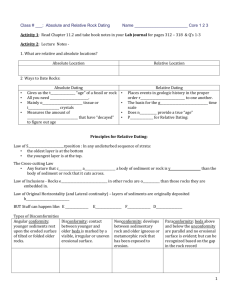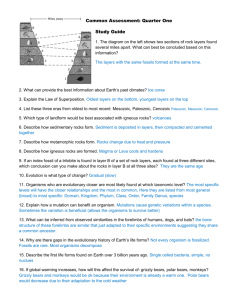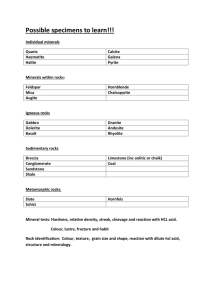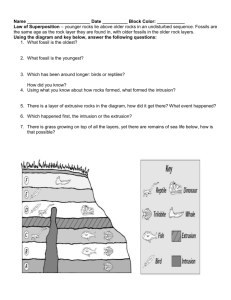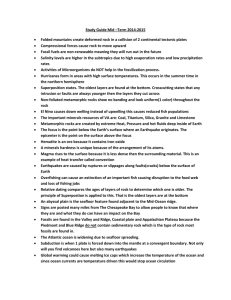Chapter 21 Fossils and the Rock Record
advertisement
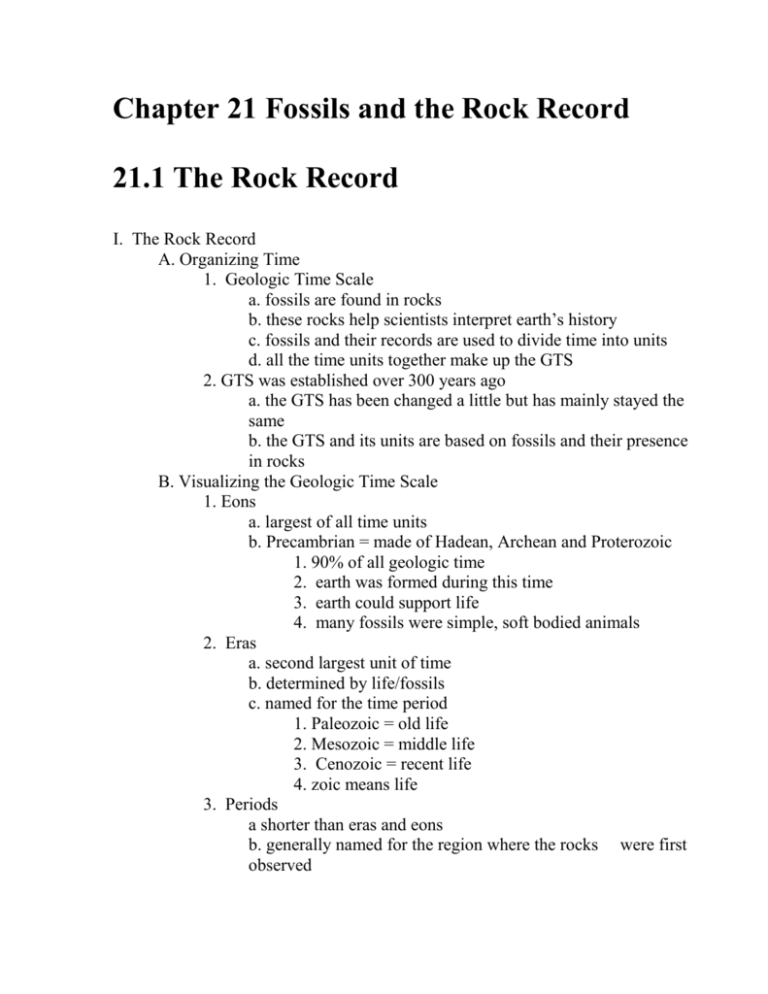
Chapter 21 Fossils and the Rock Record 21.1 The Rock Record I. The Rock Record A. Organizing Time 1. Geologic Time Scale a. fossils are found in rocks b. these rocks help scientists interpret earth’s history c. fossils and their records are used to divide time into units d. all the time units together make up the GTS 2. GTS was established over 300 years ago a. the GTS has been changed a little but has mainly stayed the same b. the GTS and its units are based on fossils and their presence in rocks B. Visualizing the Geologic Time Scale 1. Eons a. largest of all time units b. Precambrian = made of Hadean, Archean and Proterozoic 1. 90% of all geologic time 2. earth was formed during this time 3. earth could support life 4. many fossils were simple, soft bodied animals 2. Eras a. second largest unit of time b. determined by life/fossils c. named for the time period 1. Paleozoic = old life 2. Mesozoic = middle life 3. Cenozoic = recent life 4. zoic means life 3. Periods a shorter than eras and eons b. generally named for the region where the rocks were first observed 4 Epochs a. even smaller divisions of time b. rocks from the Cenozoic era are the best preserved due to being newer and less subjective to weathering and erosion c. Succession of Life-forms 1. early life was very simple 2. as time went by life became more complex 3. Age of Dinosaurs a. Mesozoic b. all different species thrived during this time 4. Rise of mammals a. Cenozoic b. increased numbers c. increased diversity d. human ancestors appeared 21.2 Relative-Age Dating II. Relative-Age Dating A. Interpreting Geology 1. Uniformitarianism i. James Hutton ii. The present is the key to the past iii. By understanding what is going on today we can figure out what happened in the past B. Principles for Determining Relative Age 1. Relative-age dating i. Using a comparison ii. Older than…..younger than…. 2. Original horizontality i. Applies to sedimentary rocks ii. Sedimentary rocks are deposited in horizontal layers iii. Good example = Grand Canyon 3. Superposition i. Oldest layer is deposited first or on the bottom ii. Youngest layer is deposited last or on top iii. Assuming the rock layers have been undisturbed 4. Cross-cutting relationship i. Rocks that cut into other rocks have to be younger than the rocks they cut into ii. Generally this applies to igneous intrusions iii. Same applies to faults 1. the fault is younger than the rock it cuts into 5. Inclusion i. A rocks that is inside another rock must be older ii. The rocks inside had to be there for another rock to cool around it 6. Unconformities i. Break in the rock record ii. Buried surfaces of eroded rock 7. Disconformity i. Erosion layer that is between two sedimentary rock layers ii. Sometimes hard to see 8. Angular unconformity i. Layers of horizontal sediment is deposited on top of layers that have been tilted ii. Tilting is most likely from mountain building C. Correlation 1. matching up of layers of rock formations from one area to another 2. help scientists tell the history of one region as compared to another 3. key beds i. layer of sediment that is deposited over a large area ii. can result due to volcanic eruption and lots of ash in the air iii. can also result from large meteorite that hits earth and sends up tons of sediment into the air iv. a great example is the Mount St. Helens ash layer v. great for relative dating 21.3 Absolute-Age Dating III. Radioactive ______________ a. Absolute-age i. Absolute-age dating allows scientists to give a fossil or rock layer a ____________ for its age ii. Measures the amount of ___________ that happens iii. Original material = _________________________ iv. Decayed material = _________________________ v. Parent material + daughter material must equal _________ because no material is ever _____________ vi. This process is called ____________________ b. ___________________ dating i. Half life 1. amount of time it takes for ___________ of an objects element to decay 2. material ___________________ every half life ii. dating rocks 1. rocks use ________________ dating 2. Uranium 238 is the chemical used for dating rocks 3. Uranium does not ___________________________________ 4. U-238 has a half life of ________________ years c. Radiocarbon dating i. Used to date fossils or things that were ______________________ ii. Carbon-14 is used to date fossils or once living organisms d. Other ways to date for absolute i. Tree rings 1. _________ ring per year 2. thick rings = ______________________, lots of rain and food 3. provide information about environment and _____________________________________________ ii. ___________ cores 1. like _________________ 2. can tell past environments 3. used to study _________ changes 21.4 Fossil Remains I. The fossil record a. Original remains

